|
|
|
Sort Order |
|
|
|
Items / Page
|
|
|
|
|
|
|
| Srl | Item |
| 1 |
ID:
128258
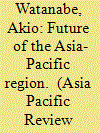

|
|
|
|
|
| Publication |
2013.
|
| Summary/Abstract |
This article discusses the origin and significance of the designation of the area surrounding Japan as the Asia-Pacific region. It then outlines the members of the region and the various organizations in which they participate. After describing the economic and cultural achievements to date, the article points out the issues challenging the Asia-Pacific region and encourages leaders in this "security complex" to remove obstacles to peace and security going forward in the twenty-first century.
|
|
|
|
|
|
|
|
|
|
|
|
|
|
|
|
| 2 |
ID:
128256
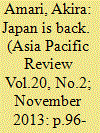

|
|
|
|
|
| Publication |
2013.
|
| Summary/Abstract |
Japan's economy has gone through more than a decade of deflation. Following the inauguration of the Abe Administration in December 2012, "Abenomics" has prioritized exiting deflation, revitalizing the economy and getting Japan back on the road toward fiscal health. This article discusses the efforts to create three virtuous cycles as Japan aims to regain its position as a leader in the global economy and proposes a prescription for resolving common challenges in the future.
|
|
|
|
|
|
|
|
|
|
|
|
|
|
|
|
| 3 |
ID:
128261
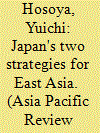

|
|
|
|
|
| Publication |
2013.
|
| Summary/Abstract |
For much of its postwar history, Japan's diplomacy consisted of three pillars: "the United Nations Centrism," "cooperation with free countries," and "being a member of Asia." However, beginning in the twenty-first century, two new diplomatic strategies for East Asia have emerged. These two paths exhibit different philosophies which however share some elements. This article examines the "East Asian Community" vision and the "Arc of Freedom and Prosperity" initiative and identifies the key concepts that they share. Finally, it suggests that if Japan's two foreign policy visions were unified, the strategy would be strengthened.
|
|
|
|
|
|
|
|
|
|
|
|
|
|
|
|
| 4 |
ID:
128252


|
|
|
|
|
| Publication |
2013.
|
| Summary/Abstract |
Former Prime Minister of Japan Yasuhiro Nakasone recalls the days when he walked with US President Ronald Reagan and UK Prime Minister Margaret Thatcher. Together they formulated a policy for dealing with the Soviet Union and implemented deregulation to promote a market economy. Here, he recounts the early days of their collaboration.
|
|
|
|
|
|
|
|
|
|
|
|
|
|
|
|
| 5 |
ID:
128253
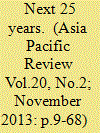

|
|
|
|
|
| Publication |
2013.
|
| Summary/Abstract |
Taking the opportunity of the twenty-fifth year anniversary, these proposals were compiled to present a view of the issues that must be addressed together with a vision of how Japanese people will live their lives in a vibrant Japan that is active on the world stage in 25 years' time. Here the effort has been to formulate an ideal national vision and to endeavor to achieve this vision without getting caught up in constraints of the current reality.
Included herein are the Charter and individual proposals. The Charter describes a vision of the country of Japan and the Japanese people. The Charter was written to clearly express a vision for Japan and the Japanese people. Furthermore, the individual proposals focus on 10 issues confronting contemporary Japan that need to be overcome. Specifically, Reverse Declining Birth Rate, Seniors Contributing to Society, Education Policy, Labor Policy, Science and Technology Policy, Energy Policy, Diplomacy and Security Policy, Fiscal/Social Security Policy, Political Reform, and Good Governance of an Aging Society: A Master Plan are the issues addressed in these proposals.
The past cannot be changed, but with a sense of purpose and action, the future can be transformed. It is we ourselves who build and create the future. In 25 years hence, as the Japanese people live in safety and comfort, filled with happiness, Japan can contribute to the international community by actively contributing to peace and prosperity around the world. That is the role that we hope Japan fulfills.
|
|
|
|
|
|
|
|
|
|
|
|
|
|
|
|
| 6 |
ID:
128259
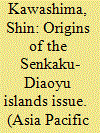

|
|
|
|
|
| Publication |
2013.
|
| Summary/Abstract |
Although news accounts cover the Senkaku/Diaoyu Islands issue, rarely is historical background given. This article focuses on Taiwanese diplomatic documents dating from after World War Two through the early 1970s, the period before Japan-China diplomatic relations were normalized, to try to clarify the timeline of when the Senkaku/Diaoyu Islands became a diplomatic issue.
|
|
|
|
|
|
|
|
|
|
|
|
|
|
|
|
| 7 |
ID:
128260
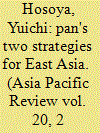

|
|
|
|
|
| Publication |
2013.
|
| Summary/Abstract |
For much of its postwar history, Japan's diplomacy consisted of three pillars: "the United Nations centrism," "cooperation with free countries," and "being a member of Asia." However, beginning in the twenty-first century, two new diplomatic strategies for East Asia have emerged. These two paths exhibit different philosophies which however share some elements. This article examines the "East Asian Community" vision and the "Arc of Freedom and Prosperity" initiative and identifies the key concepts that they share. Finally, it suggests that if Japan's two foreign policy visions were unified, the strategy would be strengthened.
|
|
|
|
|
|
|
|
|
|
|
|
|
|
|
|
| 8 |
ID:
128255
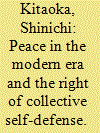

|
|
|
|
|
| Publication |
2013.
|
| Summary/Abstract |
The argument for constitutional revision has been ongoing in the post-war era but until now no action has been taken. The focal point in the discussion has been Article 9. This article argues that Japan's peace posture has not been guaranteed by Article 9. The article then turns to the right of collective defense and whether reinterpretation of Article 9 language is required in the current security environment. The conclusion calls for active and specific dialogue to resolve this issue in a timely manner.
|
|
|
|
|
|
|
|
|
|
|
|
|
|
|
|
| 9 |
ID:
128257
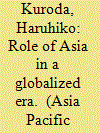

|
|
|
|
|
| Publication |
2013.
|
| Summary/Abstract |
This article first reviews the past 25 years, during which the international political situation as well as international economics and finance underwent major structural changes. It then focuses on Asia, which has recorded remarkable growth and strengthened its financial architecture since the Asian currency crisis. Issues facing Asia are detailed, together with recommendations for Asia's participation in a new international economic order.
|
|
|
|
|
|
|
|
|
|
|
|
|
|
|
|
| 10 |
ID:
128254
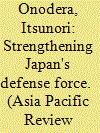

|
|
|
|
|
| Publication |
2013.
|
| Summary/Abstract |
Inaugurated in December 2012, the second Abe administration embarked upon a number of initiatives, including recovery after the Great East Japan Earthquake and economic revitalization. Japan's defense force is also an area for review and deliberation. To be better prepared to respond to natural disasters as well as to promote cooperation in the Asia-Pacific region, Japan is pursuing strengthened defense force for its national interest in a harmonized manner with regional interests and global security.
|
|
|
|
|
|
|
|
|
|
|
|
|
|
|
|
| 11 |
ID:
128263
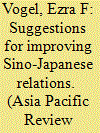

|
|
|
|
|
| Publication |
2013.
|
| Summary/Abstract |
Japan should avoid actions China considers provocative. Japanese top leaders should not visit Yasukuni Shrine and should reaffirm Japan's apologies for tragedies caused by their invasions.
China should not use armed pressure in an effort to determine the sovereignty of territories claimed by Japan and should reaffirm its determination to prevent demonstrations against Japanese.
Chinese and Japanese representatives should seek a formula so both sides could with honor back down from confrontations over territorial disputes such as the Senkaku/Diaoyudao Islands, and affirm their determination to resolve these issues peacefully at a later time.
Both sides should select a small number of high level leaders likely to play an important role in their government for many years ahead. These leaders, representing their respective countries, should meet frequently for comprehensive discussions on a broad range of issues to strengthen mutual understanding and cooperation. Japan should select leaders representing major political parties so that whichever political party is in power policies could continue without interruption.
|
|
|
|
|
|
|
|
|
|
|
|
|
|
|
|
| 12 |
ID:
128262


|
|
|
|
|
| Publication |
2013.
|
| Summary/Abstract |
In the two and a half years since the March 11, 2011 earthquake and tsunami disaster followed by the nuclear accident at Fukushima power plant, the Japanese government has been investigating the cause as well as assessing the responses taken as disaster management. This article analyzes the measures taken and makes recommendations for clarifying responsibility to improve efficiency and effectiveness in mitigating damage after a large-scale disaster.
It is highly regrettable that, although the result of a massive earthquake and tsunami of an unprecedented scale, the accident at the Fukushima nuclear power plant developed into a core meltdown, releasing nuclear material and forcing many residents to evacuate their homes. The crisis has undermined public faith in the safety of nuclear power generation. The Japanese government and Tokyo Electric Power Company (TEPCO) must conduct a thorough investigation into the cause, and review and assess the validity of the existing emergency response procedures as well as the relevancy of the measures actually taken for resident evacuation and radiation damage control in collaboration with the International Atomic Energy Agency (IAEA) and other international and government agencies. Sharing the results internationally will help improve nuclear safety around the world.
The biggest problem surrounding the accident was the intricate chain of command and control for disaster management. Since the authority and responsibility of the agencies concerned were extremely ambiguous, the government was unable to make good use of the systems and institutions designed to cope with nuclear disasters. To make matters worse, newly created posts and entities complicated the problem.
|
|
|
|
|
|
|
|
|
|
|
|
|
|
|
|
|
|
|
|
|